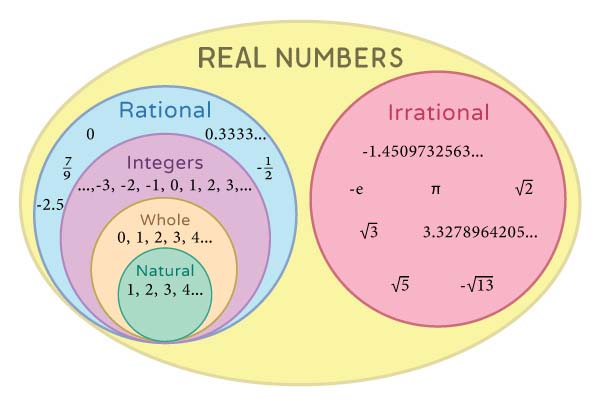Real numbers are a set of numbers that includes all rational and irrational numbers. In other words, real numbers are the numbers you typically encounter in everyday life, and they can be located on the number line. Real numbers are defined as the set of all possible values that can be represented as decimals, both terminating and non-terminating (repeating or non-repeating).
Here’s a more formal definition of real numbers:
Table of Contents
Real Numbers:
The set of real numbers, denoted by R, includes all numbers that can be expressed in decimal form, either as finite decimals (terminating) or as infinite decimals (non-terminating and either repeating or non-repeating). This set encompasses all rational numbers (numbers that can be expressed as a fraction) and irrational numbers (numbers that cannot be expressed as a fraction and have non-repeating, non-terminating decimal expansions).
Real numbers encompass a wide range of values, including integers, fractions, decimals, and numbers like π (pi) and √2 (the square root of 2), which cannot be expressed as simple fractions. They are essential in mathematics and science for describing and representing quantities in a continuous and unbroken manner.
Real numbers include a wide range of values, and here are some examples of real numbers:
- Integers: Integers like -3, -2, -1, 0, 1, 2, 3, and so on are real numbers.
- Fractions: Numbers like 1/2, 3/4, -2/5, and 7/3 are real numbers.
- Decimals: Numbers such as 0.5, 3.14159265359 (π or pi), 2.71828182846 (e), and 1.41421356237 (√2) are real numbers.
- Irrational Numbers: Numbers that cannot be expressed as fractions, such as √2 (the square root of 2), √3 (the square root of 3), and π (pi), are real numbers.
- Repeating Decimals: Numbers like 0.666… (repeating 6s) and 0.272727… (repeating 27s) are real numbers.
- Non-repeating Decimals: Numbers like 0.123456789101112131415… (the decimal expansion of Champernowne’s constant) are real numbers and are non-repeating.
These examples represent the diversity of real numbers, including both rational (integers, fractions, repeating decimals) and irrational numbers (non-repeating decimals) that can be found on the real number line. Real numbers are used in a wide range of mathematical and scientific applications.

Euclid division algorithm
The Euclidean division algorithm is a method used to find the quotient and remainder when dividing one integer by another. It is named after the ancient Greek mathematician Euclid, who described it in his work “Elements.”
The Euclidean division algorithm can be stated as follows:
Given two integers, a (the dividend) and b (the divisor), where b is not equal to 0, you can find two unique integers, q (the quotient) and r (the remainder), such that:
a = bq + r
Here’s a step-by-step explanation of how the Euclidean division algorithm works:
- Start with the values of a and b.
- Divide a by b to find the quotient q.
- Calculate the remainder r by subtracting b * q from a.
- If r is not zero, set a = b and b = r, then repeat steps 2 and 3.
- Continue this process until r becomes zero.
- The last non-zero remainder obtained in the process is the greatest common divisor (GCD) of a and b.
The Euclidean Division Algorithm is often used to find the GCD of two numbers, but it can also be used to express one number as a multiple of another with a remainder. It’s a fundamental tool in number theory and is used in various mathematical and algorithmic applications.
Let’s illustrate this with an example:
Suppose we want to find the GCD of 48 and 18 using the Euclidean Division Algorithm:
- Initially, a = 48 and b = 18. Divide 48 by 18 to get q = 2 and r = 12: 48 = 18 * 2 + 12
- Since r is not 0, we replace a with 18 and b with 12: a = 18, b = 12
- Now, divide 18 by 12 to get q = 1 and r = 6: 18 = 12 * 1 + 6
- Again, r is not 0, so we replace a with 12 and b with 6: a = 12, b = 6
- Divide 12 by 6 to get q = 2 and r = 0: 12 = 6 * 2 + 0
Since we’ve reached a remainder of 0, the GCD of 48 and 18 is 6.
The Euclidean Division Algorithm is a fundamental tool for finding the GCD and is often used in simplifying fractions and solving various mathematical problems.
EXERCIES-1.1
- Use Euclid’s division algorithm to find the HCF of
i) 900 and 270
Sol. 900 = 270 × 3 + 90
270 = 90 × 3 + 0
.. HCF =90
ii) 196 and 38220
Sol. 38220 = 196 × 195 + 0
196 is the HCF of 196 and 38220.
iii) 1651 and 2032
Sol. 2032 = 1651 × 1 + 381
1651 = 381 × 4 + 127
381 = 127 x 3 +0
.:. HCF= 127
- Use Euclid division lemma to show that any positive odd integer is of the form 6q + 1 or 6q +3 or 6q +5, where q is some integers.
Sol. Let ‘a’ be an odd positive integer.
Let us now apply division algorithm
with a and b = 6.
0<r<6, the possible remainders
are 0, 1, 2, 3, 4 and 5.
i.e., ‘a’can be 6q or 6q + 1 or 6q + 2 or
6q + 3 or 6q + 4 or 6q + 5, where q is
the quotient.
But ‘a’ is taken as an odd number.
.:. a can’t be 6q or óq + 2 or 6q + 4.
.. Any odd integer is of the form
q + 1, 6q + 3 or 6q + 5.
- Use Euclid’s division lemma to show that the square of any positive integer is of the form 3p, 3p + 1.
Sol. Let ‘a’ be the square of an integer.
Applying Euclid’s division lemma with
a and b=3
Since 0<r<3, the possible remain
ders are 0, 1, and 2.
.. a = 3q (or) 3q + 1 (or) 3q + 2
Any square number is of the form
3q, 3q + 1 or 3q + 2, where g is the
quotient.
(or)
Let ‘a’ be a positive even integer then a is of the form 2p. and a? = (2p)?
= 4p= 2 (2p)
= 2k (where k = 2p’)
again an even integer.
If ‘a’ is an odd number, then ‘a’ is of the
form 2p + 1. a? = (2p + 1)’ = 4p + 4p + 1
= 2 (2p² + 2p) + 1
a =3p
= 2k + 1 (where k= 2p² + 2p)
again an odd integer.
Now applying Euclid’s division lemma
with a and b = 3
= 3p + 1
= 3p + 2
where p is quotient and 0, 1, 2 are the possible remainders.
‘a’can be considered as square of an integer.
i. Any square number is of the form
3p or 3p+ 1.
4. Use Euclid’s division lemma to show that the cube of any positive integer is of the form 9m, 9m + 1 or 9m + 8.
Sol. Let ‘a’ be the cube of a positive integer. Applying Euclid’s division lemma for
a and b =9.
a = bm +r where ‘m’ is quotient and
‘r is the remainder, where 0sr<9.
.:. ‘a’ can be of the form
9m, 9m + 1. 9m +2…….. or 9m + 8
.. The cube of any positive integer is of the form
9m, 9m + 1.9m + 2……… or 9m + 8.
5. Show that one and only one out of n, n + 2 or n + 4 is divisible by 3, where n is any positive integer.
Sol. Let a = n orn + 2 orn + 4 and b=3.
Now by Euclid’s division lemma
a = bq +r where q is quotient and
0<r< 1, ris the remainder.
.”. a can be of the formn or n + 1 or
n + 2.
We note that when n divides n + 4
leaves same remainder as it divides
n +1
. Only one out of n, n + 2 or n + 4 is divisible by 3.
(or)
Let ‘n’ be any positive integer.
Case (i) : If n is completely divisible by 3 then n + 2 and n + 4 are not completly divisible by 3.
Case (ii) : If n is not completely divisible by 3 then ‘n’ leaves remainder 1 or 2.
Now if n + 1 is divisible by 3 neither n or n + 2 is divisible by 3.
Note that n + 1 and n + 4 leaves
same remainder when divided by 3.
If n + 2 is dËvisible by 3 then nei
ther n + 4 or n are divisible by 3.
Hence proved.

